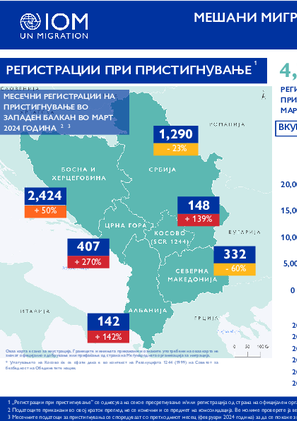-
Countries
-
Data and Analysis
-
Special Focus
-
Crisis Responses
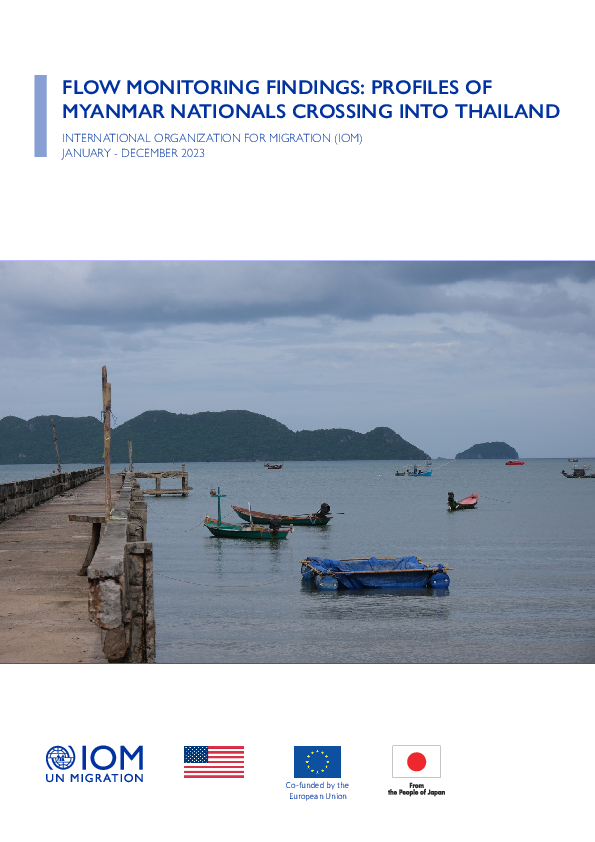
Contact
DTM Thailand, dtmthailand@iom.int
Language
English
Location
Thailand
Period Covered
Jan 01 2023
Dec 31 2023
Activity
- Survey
- Flow Monitoring
To gain a better understanding of the mobility dynamics and vulnerabilities of Myanmar nationals entering Thailand, IOM Thailand initiated flow monitoring activities at key points of entry (POEs) in Tak, Ranong, and Kanchanaburi border provinces in 2023 using IOM Displacement Tracking Matrix (DTM) tools. Flow monitoring aims track the scale and characteristics of Myanmar nationals’ mobility along the Myanmar-Thailand border, including the volume of movements and intended destinations of migrants, their reasons for movement, intended lengths of stay, and expectations about work sectors and conditions. The tool provides critical insights into current mobility dynamics in the context of the socio-economic and security situation in Myanmar following the military takeover in February 2021. The following report extends findings from the mid-year flow monitoring report published in September 2023. It covers the entire year of 2023 in Tak and Ranong, and additionally includes analysis of Kanchanaburi province from September to December 2023.
Flow Monitoring Counting (FMC) and Flow Monitoring Surveys (FMS) are conducted simultaneously at each point for one week every month. Tak, Kanchanaburi, and Ranong were chosen due to pre-existing information indicating that the three provinces experience a substantial volume of entries of Myanmar nationals.
From January to December 2023, IOM’s Migration Data and Research Unit (MDRU) interviewed a total of 4,693 incoming Myanmar nationals to Thailand, with 2,366 interviewed in Tak province (50%), 2,310 in Ranong province (49%), and 17 in Kanchanaburi province (1%).
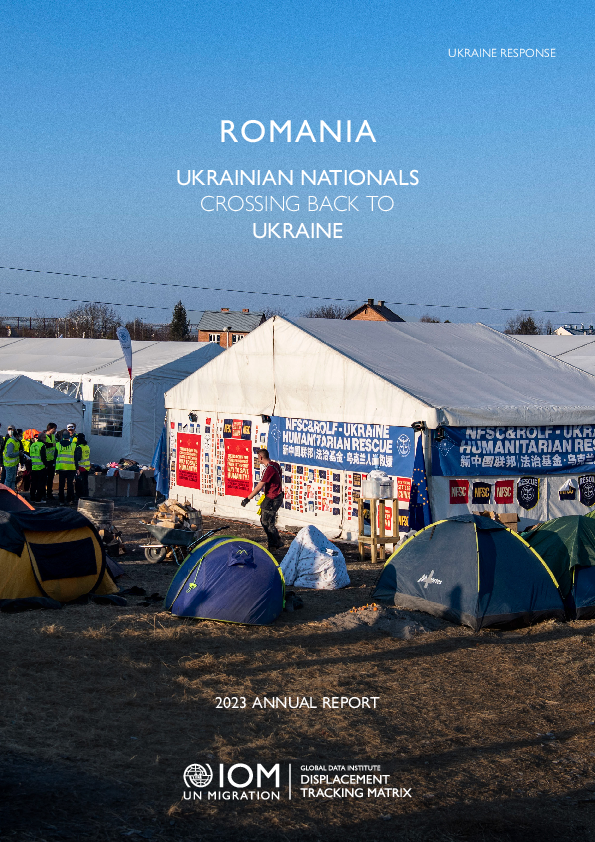
Contact
DTM Europe, DTMMediterranean@iom.int
Language
English
Location
Romania
Period Covered
Jan 01 2023
Dec 31 2023
Activity
- Survey
- Return Intention
- Flow Monitoring
This report employs data collected within the framework of the Crossing Back surveys conducted in Romania between January and December 2023 with Ukrainian nationals who were either crossing back for a short-time visit or returning for a long-term period to Ukraine from or through Romania. The analysis considers ‘’short-term visitors’’ those persons who intended to spend 0-30 days in Ukraine, while respondents planning to stay for more than a month are defined as “prospective returnees”.
The survey included answers from 5,773 Ukrainian nationals living in or passing through Romania who were travelling to Ukraine. Among those interviewed before crossing back into Ukraine, the majority stayed in Romania (59%), followed by Bulgaria (17%) or Germany (5%). Additional countries of residence included Italy (4%), the United Kingdom of Great Britain and Northern Ireland (3%), Türkiye (2%), Belgium (2%), Greece (1%), Austria (1%), with the remaining 6% distributed among other nations.
The travel intentions of the surveyed Ukrainian nationals show that most respondents (53%) were “short-term visitors”, while 27 per-cent were prospective returnees. Another 20 per cent were not sure regarding their visit period. Also, most UA citizens were travelling back to their oblast of origin (93%), with most respondents originating from Odeska, Chernivetska, Mykolaivska, Ivan-Frankivska, City of Kiyv and Kharvivska.
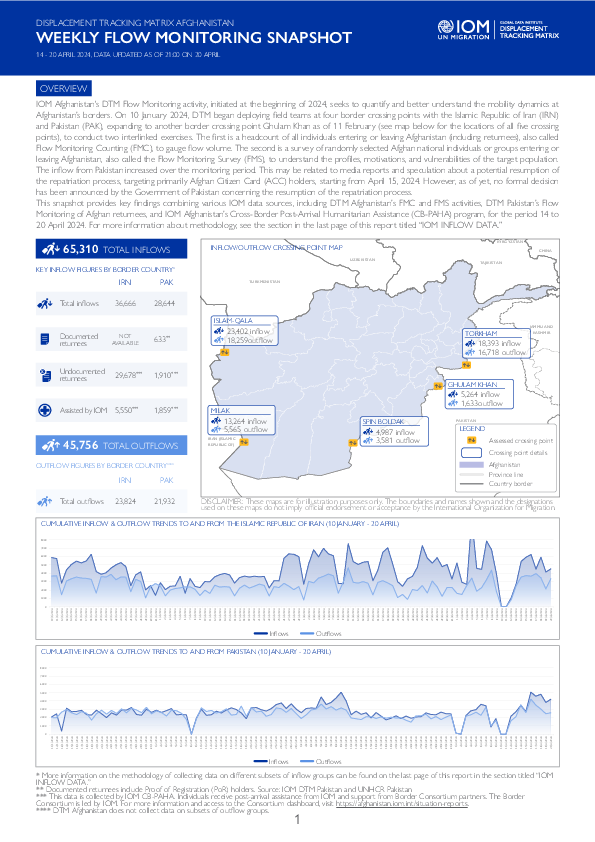
Contact
DTMAfghanistan@iom.int
Language
English
Location
Afghanistan
Period Covered
Apr 14 2024
Apr 20 2024
Activity
- Survey
- Flow Monitoring Survey
- Flow Monitoring
IOM Afghanistan's DTM Flow Monitoring activity, initiated at the beginning of 2024, seeks to quantify and better understand the mobility dynamics at Afghanistan’s borders. On 10 January 2024, DTM began deploying field teams at four border crossing points with the Islamic Republic of Iran (IRN) and Pakistan (PAK), expanding to another border crossing point Ghulam Khan as of 11 February (see map below for the locations of all five crossing points), to conduct two interlinked exercises. The first is a headcount of all individuals entering or leaving Afghanistan (including returnees), also called Flow Monitoring Counting (FMC), to gauge flow volume. The second is a survey of randomly selected Afghan national individuals or groups entering or leaving Afghanistan, also called the Flow Monitoring Survey (FMS), to understand the profiles, motivations, and vulnerabilities of the target population. The inflow from Pakistan increased over the monitoring period. This may be related to media reports and speculation about a potential resumption of the repatriation process, targeting primarily Afghan Citizen Card (ACC) holders, starting from April 15, 2024. However, as of yet, no formal decision has been announced by the Government of Pakistan concerning the resumption of the repatriation process.
This snapshot provides key findings combining various IOM data sources, including DTM Afghanistan’s FMC and FMS activities, DTM Pakistan’s Flow Monitoring of Afghan returnees, and IOM Afghanistan’s Cross-Border Post-Arrival Humanitarian Assistance (CB-PAHA) program, for the period 14 to 20 April 2024. For more information about methodology, see the section in the last page of this report titled “IOM INFLOW DATA.”

Contact
DTM Yemen, IOMYemenDTM@iom.int
Language
English
Location
Yemen
Period Covered
Jan 01 2023
Dec 31 2023
Activity
- Survey
- Displacement Solutions
- Mobility Tracking
- Event Tracking
- Baseline Assessment
Please note that this report is divided into three sections:
- Area Assessment (AA)
- Rapid Displacement Tracking (RDT)
- The IDP Intention Survey (IS)
The report contains cross-cutting descriptive analyses from a combination of data sources to provide the best possible overview.
The Area Assessment remains the most suitable source of information on target population sizes and locations. Rapid Displacement Tracking (RDT) should be understood as indicative of new displacement events and trends without serving as a source of population sizes as households may experience multiple displacements during the reporting period or might have returned before the end of the reporting period. Both the Area Assessment and RDT are based on key informant interviews. The intention survey (here based on 13,307 face-to-face interviews in May 2023) serves to provide insights into past and present motives of displaced populations, thereby providing a more personal profile of affected populations.

Contact
DTM Nigeria, iomnigeriadtm@iom.int
Language
English
Location
Nigeria
Period Covered
Mar 01 2024
Mar 31 2024
Activity
- Other
A total of 316 alerts were recorded in March 2024. Among these, 283 alerts (90%) were classified as events, while 33 (10%) related to movements. All alerts in Demsa, Lamurde, Girei, and Shelleng LGAs in Adamawa state were event-related. In Numan LGA, event alerts accounted for 96 per cent of reported alerts, while 4 per cent were movement alerts. Similarly, in Mayo-belwa LGA, event alerts comprised 95 per cent of alerts, while movement alerts constituted 5 per cent. In Guyuk LGA, 80 per cent of alerts were event-related, with the remaining 20 per cent credited to movement alerts. In Taraba state, Zing LGA reported 67 per cent of event-related alerts and 33 per cent are movement-related of cattle. Additionally, Lau LGA reported 67 per cent movement-related alerts and 33 per cent are event-related. Disaggregated ward-level data indicates that Kodompti and Demsa wards in Numan LGA and Demsa LGA of Adamawa state reported the highest percentage of events, each comprising 8 per cent of the total alerts.
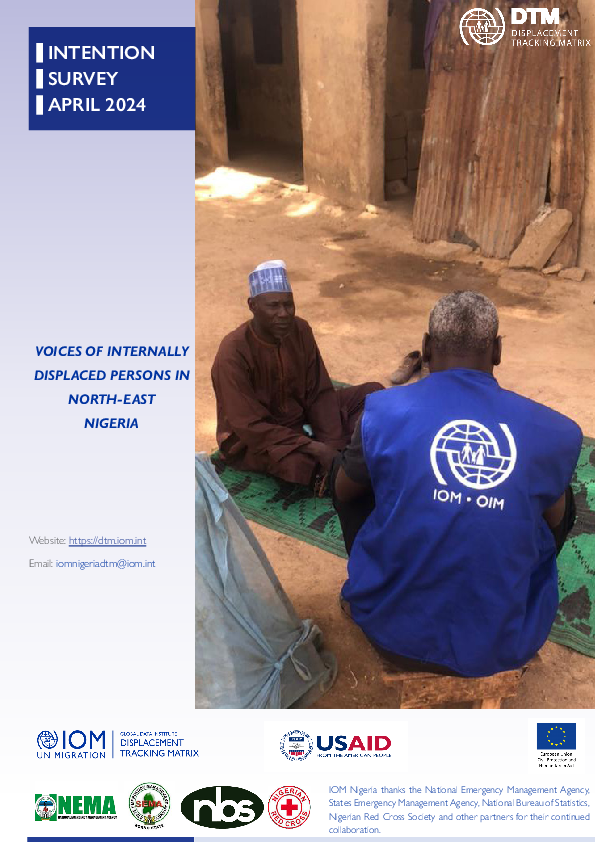
Contact
DTM Nigeria, iomnigeriadtm@iom.int
Language
English
Location
Nigeria
Period Covered
Nov 16 2023
Dec 18 2023
Activity
- Survey
The aim of the survey was to shed light on the voices and aspirations of IDPs regarding their preferred durable solutions within the next 12 months or one year, to facilitate evidence-based decision-making, and policy and programme planning around durable solutions. A durable solution is achieved when IDPs no longer have any specific assistance and protection needs that are linked to their displacement and can enjoy their human rights without discrimination on account of their displacement. The intentions such as ‘return to the place of origin’, ‘integrate into the current location’, or ‘relocate to a new location’ which were assessed during the survey were indicative of the preferred Solutions of IDPs.
The survey brought to light that a large portion (37%) of the respondents intend to return to their place of origin. Also, almost the same proportion of the respondents intended to integrate into their current location (38%). The largest number of respondents who expressed their desire to return were in Borno State. Similarly, most of the respondents who wished to integrate because of the security situation were good in their current location. Regionally, the respondents in the LGAs towards the west of the region were more inclined to integration compared to those LGAs towards the northern parts. The survey also revealed that two per cent of the respondents prefer to relocate to another LGA or state. The majority of those who intended to relocate preferred the LGAs within their state of current displacement.
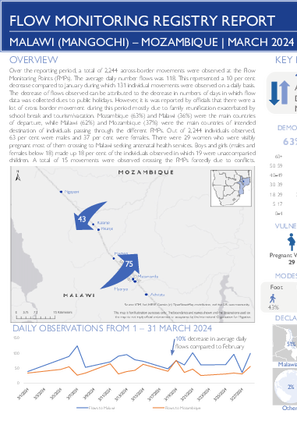
Contact
ROPretoriaRMDHub@iom.int
Language
English
Location
Malawi
Period Covered
Mar 01 2024
Mar 31 2024
Activity
- Flow Monitoring
This report is an overview of the data collected from 1 to 31 March 2024 at Mangochi FMP in Malawi along the border with Mozambique and Karonga FMP in Malawi along the border with the United Republic of Tanzania. The Flow Monitoring Registry (FMR) collects data at Flow Monitoring Points (FMPs) through direct observation and interviews with key informants, including staff working at transit stations, border patrol officers, local authorities, bus or taxi drivers and travellers themselves. The FMR gathers data on the number of travellers crossing FMPs, as well as the provenance, next destination, vulnerabilities and means of transport of travellers.
Месечен преглед на:
- Пристигнувања во Западен Балкан
- Топ три националности на лица кои пристигнале во месецот на известување
- Присуство на мигранти во прифатните објекти
- Доброволно асистирано враќање и реинтеграција
Contact
DTM Sudan, DTMSudan@iom.int
Location
Sudan
Activity
- Mobility Tracking
- Baseline Assessment
Period Covered
Apr 05 2024 -Apr 12 2024
- DTM Sudan estimates that 6,680,850 individuals (1,330,933 households) were recently internally displaced.
- The IDP caseload was observed in 7,143 locations across all of Sudan’s 18 states.
- The highest proportions of IDPs were observed across South Darfur (11%), River Nile (11%), and East Darfur (10%).
- Field teams reported that the IDPs observed were originally displaced from twelve states. The majority (3,560,858 IDPs, 54%) were reportedly displaced from Khartoum state; followed by South Darfur (15%), Aj Jazirah (10%), North Darfur (9%), Central Darfur (4%), West Darfur (4%), South Kordofan (2%), East Darfur (1%), West Kordofan (1%), North Kordofan (1%), Sennar (1%) and White Nile (<1%).
- IOM-DTM also reported that an estimated 2,050,391 mixed cross-border movements were made into neighbouring countries.
A more detailed version of this dataset is available, to get access kindly click on the 'Request Access' button
Population Groups
IDPs
Survey Methodology
Unit of Analysis Or Observation
Site or Location
Type of Survey or Assessment
Key Informant
Keywords
Geographical Scope Partial Coverage
Administrative boundaries with available data
The current dataset covers the following administrative boundaries
Contact
DTMMali@iom.int
Location
Mali
Activity
- Mobility Tracking
- Baseline Assessment
Period Covered
Oct 01 2023 -Dec 31 2023
During the data collection and update operation conducted in December 2023, a total of 354,739 IDPs were identified. The number of IDPs indeed decreased from 391,961 individuals in September 2023 (September 2023 DTM report) to 354,739 in December 2023. Therefore, from September 2023 to December 2023, a decrease of 37,222 displaced persons (approximately 9% decrease) was observed.
Population Groups
IDPs
Returnee (Previously Internally Displaced)
Survey Methodology
Unit of Analysis Or Observation
Admin Area 3
Individual
Type of Survey or Assessment
Key Informant
Keywords
Geographical Scope Full Coverage
Administrative boundaries with available data
The current dataset covers the following administrative boundaries
